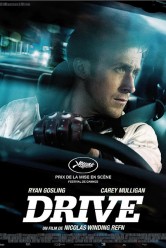Drive
“Drive”- Idem, Estados Unidos 2011
Direção: Nicolas Winding Refn
Este não é um filme de ação igual aos outros.
Porque tem um roteiro seco e inteligente (do iraniano Hussein Amini), uma direção talentosa e premiada no último Festival de Cannes (do dinamarquês Nicolas Winding Refn), um excelente ator de 31 anos nascido no Canadá (Ryan Gosling) e não tem tanta ação assim. Tem mais drama e leva jeito de se tornar um filme “cult”, logo, logo.
O belo Ryan Gosling, o melhor ator de sua geração, tem uma presença fria e elegante no filme, como se fosse um tigre na selva. Não tem nome e fala pouco.
Tranquilo, dirige calmamente seu Chevrolet Impala, com luvas especiais de couro.
De dia ele trabalha em uma oficina e faz dublê de artistas de Hollywood em perigosos acidentes de carro. De noite é o motorista que tira criminosos da cena do crime. Ele não se envolve e só espera cinco minutos. E avisa antes.
Ninguém diria que ele é capaz de violência. Nem de apegos amorosos.
Mas preparem-se para ver coisas de gelar os ossos.
O dinamarquês, criado em New York, Nicolas Winding Refn, dá um toque de arte em sua direção premiada, usando a câmara ora fixa, seguindo o inabalável Ryan, durante a noite, dirigindo seu carro entre as luzes coloridas de Los Angeles, ora nervosa, pressentindo o que vai acontecer. Os golpes do motorista, que usa seus punhos como armas ou martelos ou a arma do bandido que o atacou, são quase todos filmados com câmara baixa, do ponto de vista da vitima.
Tudo muito rápido e sangrento.
Com sua jaqueta brilhante, ele percorre o filme todo exibindo um enorme escorpião dourado nas costas.
Lembram-se da piada da rã e a travessia do rio com o escorpião nas costas? Pois o motorista tem momentos escorpião e momentos gatinho doméstico. Ataca quem o ataca. Não toma a dianteira. Não porta armas. Mas não perdoa e nem diminue a fúria de seus músculos até matar.
Não sabemos nada sobre o passado desse personagem que nem nome tem. Ele é o momento presente, o arranque do carro e dos cinco sentidos aguçados.
E o som, única indicação para o Oscar que o filme conseguiu, é magistral. Longos silêncios rompidos por música incidental original de Cliff Martinez, bandas que cantam músicas dançantes dos anos 80 e ruídos de lutas, seguidos de sonoros esmagamentos de crânios ou rompimento de tecidos e ossos do corpo dos inimigos. Impressionante.
Carey Mulligan é o contraponto de tanta masculinidade. São dela os momentos ternos e delicados de “Drive”. Toca o sagrado apelo ao amor que também habita o coração do nosso herói.
Baseado no romance de mesmo nome de James Sallis, “Drive” é pouco americano e bastante contemporâneo. Se você for tudo isso, vai gostar do filme.


Olá Eleonora,
“Drive” é sem dúvida um filme surpreendente na medida em que poderia ser mais um filme com a recorrencia do tema. Mas é o roteiro primoroso que dá a este filme uma altura de gde porte seguida da direção exemplar e madura de Nicolas Winding Refn.
A perseguição dos carros que poderia ser “mais uma”, deixa de ser pelo timing especial que acontece num tempo inesperado e preciso, alinhavado por uma trilha sonora contundente.
Percebe-se em vários momentos, a admiração do diretor pelo Tarantino nas cenas expressionistas e “vermelhas” do filme. Faz sentido no contexto me parece do filme.
Ryan Gosling, mestre na economia de suas interpretações nos apresenta um vilão moderno e glacial seja na expressão imutável ou no gestual.Carey Mulligan tem o fisique da “ordinary american” que alem de boa atriz é perfeita para este papel.
E como vc disse, este não é um filme igual aos outros. A sensibilidade leva um “susto” com este filme.Eu levei…
bjss
Sonia Clara
Querida,
O filme é mesmo surpreendente. Ficou na prateleira dos distribuidores até passar o Oscar…Mas valeu esperar por ele!
Bjs
Vou ver!!
Ta linda na foto!
Bjs
Lili querida,
Obrigada pelo elogio!
O filme é surpreendente apesar da gente não gostar mt de ver lutas e sangue…
Bjs
Nullam hendrerit eros ut nunc iilcuas blandit. Curabitur eget risus at nisl vehicula euismod quis at justo. Morbi ac ultrices odio. Praesent vel tincidunt felis.GD Star Ratingloading…GD Star Ratingloading…
I am currently in the Army, and will be ririteng in just over a year. I am looking at truck driving schools in Iowa. I am considering Iowa Central C.C. Does anyone know about the program, that has been through it? Was it good, bad, ugly, indifferent?Dave
Howdy I am so happy I found your blog page, I really found you by mistake, while I was looking on Aol for something else, Anyhow I am here now and would just like to say thank you for a incredible post and a all round exciting blog (I also love the theme/design), I don’t have time to look over it all at the minute but I have saved it and also included your RSS feeds, so when I have time I will be back to read a lot more, Please do keep up the great job.
Brian Good luck with it I love flying rotor. My Cirrus is nice at 180 KIAS, but it canont hover. I have put 200 hours on my R44 since buying it new in Feb of this year I could not be happier with how it flies!
See also Ben Yagoda (Professor of English at the University of Delaware) in The American Scholar.org . When Lady Chatterley’s Lover ran afoul of Britain’s 1959 obscenity law, the risnlteug case had a cast worthy of P.G. Wodehouse . This is a really interesting article, summarizing the trial itself. Some extracts: Exactly 50 years ago, for six days in late October and early November of 1960, Penguin Books was tried in the Old Bailey for having attempted to bring out a paperback edition of D. H. Lawrence’s Lady Chatterley’s Lover, which had been banned since its 1928 publication [uncut, ]. Since 1868, obscenity had been a common-law offense, (unhelpfully) defined as any material whose tendency “is to deprave and corrupt those whose minds are open to such immoral influences.” No one seemed to have any doubt that Chatterley would fall in the dead center of that definition. Remarkably, this was the way matters stood until 1959, when liberal members of Parliament, under the leadership of Roy Jenkins, passed a new Obscene Publications Act. But the government, as it turned out, was not greatly impressed with the new law and was not inclined to give Penguin a free pass. Penguin didn’t expect such an aggressive response. [But t]he Crown was meanwhile finding out that prosecution would not be easy. The [judge’s] summing up “cast gloom on everyone from Penguin.” In the lobby as well, “the general opinion . . . seemed to be that the jurors would not take long to come up with a verdict against Penguin.” However, after just under three hours, the dock worker, the installation inspector, and the others [in the jury] filed back in and the foreman announced a unanimous verdict of not guilty. “There was an outburst of clapping,” noted The Times, “instantly silenced by the usher.” Penguin was off to the races. It printed 50,000 additional copies of the novel in seven days, then two million over the next six months. By the following year, Chatterley had brought it a profit of 112,000 pounds, the equivalent at that time of $310,000.The end of the Chatterley ban did not mark an immediate end of literary censorship in Britain. Within a few years of the trial there were successful obscenity prosecutions of Hubert Selby’s and (also known as ), banned since John Cleland wrote it in 1748 and brought to market by a publisher emboldened by the Chatterley ruling. But both rulings were overturned on , and in fairly short order the practice, in both Britain and the United States, became the present one, where the publication of more or less everything (child pornography excepted) is more or less permitted.
Vou assitir! Obrigada bjs
0 Comentários
Minha Sinopse
Nasci em São Paulo, Capital. Sou a primeira filha de sete irmãos nascidos de Yvette e Octavio Pereira de Almeida, casada com Ivo Rosset. Estudei Psicologia na PUC de SP e Direito no Mackenzie. Sou psicanalista, membro associado da Sociedade Brasileira de Psicanálise de SP. Atendo em meu consultório há mais de 30 anos. Sempre adorei cinema, desde as sessões Tom e Jerry, passando pelo Cine Bijou até o saudoso Belas Artes. Meus filmes preferidos: “Morte em Veneza” de Visconti e “Asas do Desejo” de Wim Wenders.
Buscar no blog
Curtas
“Eu e Você – Io e Te” de Bernardo Bertolucci – Lorenzo (Jacopo Olmi Antinori), um adolescente problemático, ao in
Leia mais“Malévola – Maleficent”, com Angelina Jolie – Quem perdeu esse filmão no cinema, agora pode comprá-lo a partir d
Leia mais“A Culpa é das Estrelas – The Fault in Our Stars” é o filme adaptado do best-seller de John Green – Esse filme ta
Leia maisComentados Em cartaz
Arquivo
Eleonora Rosset, 2011
Disposições Gerais
Informação de Caráter Jurídico
Lorem ipsum dolor sit amet, consectetuer adipiscing elit, sed diam nonummy nibh euismod tincidunt ut laoreet dolore magna aliquam erat volutpat. Ut wisi enim ad minim veniam, quis nostrud exerci tation ullamcorper suscipit lobortis nisl ut aliquip ex ea commodo consequat. Duis autem vel eum iriure dolor in hendrerit in vulputate velit esse molestie consequat, vel illum dolore eu feugiat nulla facilisis at vero eros et accumsan et iusto odio dignissim qui blandit praesent luptatum zzril delenit augue duis dolore te feugait nulla facilisi. Nam liber tempor cum soluta nobis eleifend option congue nihil imperdiet doming id quod mazim placerat facer possim assum.
Aplicação
Lorem ipsum dolor sit amet, consectetuer adipiscing elit, sed diam nonummy nibh euismod tincidunt ut laoreet dolore magna aliquam erat volutpat. Ut wisi enim ad minim veniam, quis nostrud exerci tation ullamcorper suscipit lobortis nisl ut aliquip ex ea commodo consequat. Duis autem vel eum iriure dolor in hendrerit in vulputate velit esse molestie consequat, vel illum dolore eu feugiat nulla facilisis at vero eros et accumsan et iusto odio dignissim qui blandit praesent luptatum zzril delenit augue duis dolore te feugait nulla facilisi. Nam liber tempor cum soluta nobis eleifend option congue nihil imperdiet doming id quod mazim placerat facer possim assum.
Lorem ipsum dolor sit amet, consectetuer adipiscing elit, sed diam nonummy nibh euismod tincidunt ut laoreet dolore magna aliquam erat volutpat. Ut wisi enim ad minim veniam, quis nostrud exerci tation ullamcorper suscipit lobortis nisl ut aliquip ex ea commodo consequat. Duis autem vel eum iriure dolor in hendrerit in vulputate velit esse molestie consequat, vel illum dolore eu feugiat nulla facilisis at vero eros et accumsan et iusto odio dignissim qui blandit praesent luptatum zzril delenit augue duis dolore te feugait nulla facilisi. Nam liber tempor cum soluta nobis eleifend option congue nihil imperdiet doming id quod mazim placerat facer possim assum.
Lorem ipsum dolor sit amet, consectetuer adipiscing elit, sed diam nonummy nibh euismod tincidunt ut laoreet dolore magna aliquam erat volutpat. Ut wisi enim ad minim veniam, quis nostrud exerci tation ullamcorper suscipit lobortis nisl ut aliquip ex ea commodo consequat. Duis autem vel eum iriure dolor in hendrerit in vulputate velit esse molestie consequat, vel illum dolore eu feugiat nulla facilisis at vero eros et accumsan et iusto odio dignissim qui blandit praesent luptatum zzril delenit augue duis dolore te feugait nulla facilisi. Nam liber tempor cum soluta nobis eleifend option congue nihil imperdiet doming id quod mazim placerat facer possim assum.